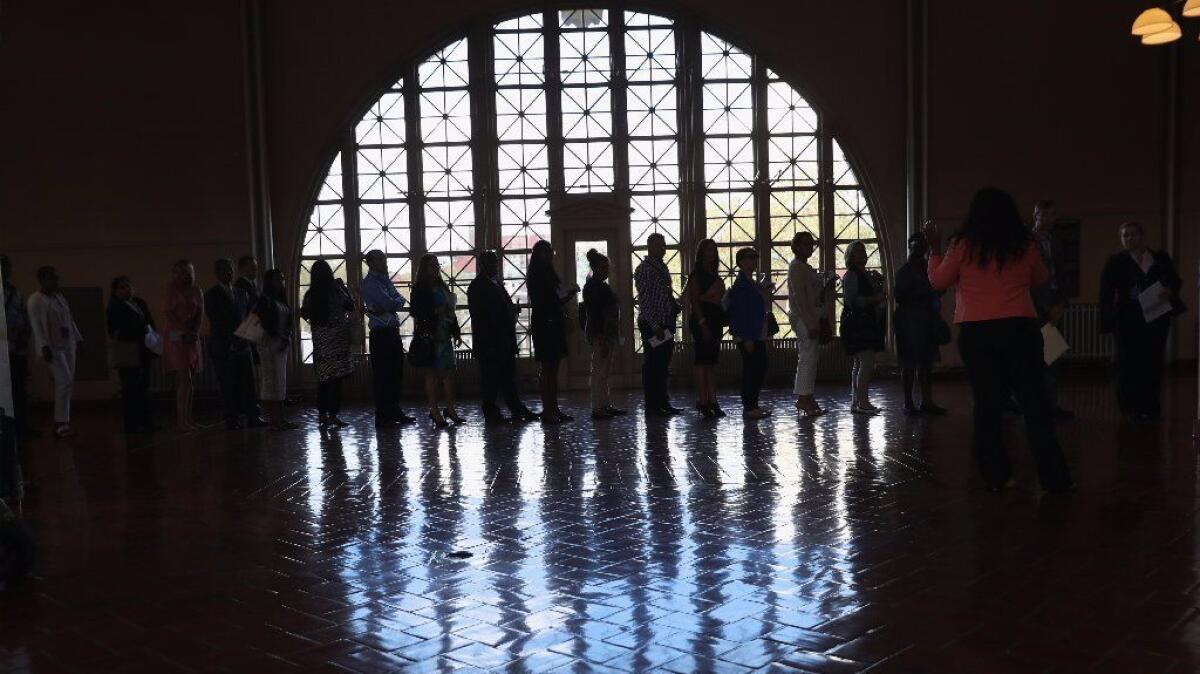Clinton’s immigration plan could help economy more than Trump’s, most economists say

Forget about tax plans and spending programs, trade deals and regulatory reform.
When it comes to influencing the speed and direction of the economy, few things will matter more than how the next president deals with the millions of immigrants in the country illegally, and just as crucially, how many new legal immigrants are allowed in each year.
“In terms of where the economy would be four years and 10 years from now, the real difference, the game changer between the two [presidential candidates] is immigration,” said Mark Zandi, chief economist at Moody’s Analytics, a forecasting firm.
By Moody’s calculations, Hillary Clinton’s more open-door position on immigration — including a pathway to citizenship for those already in the country illegally and increasing legal immigration — would add about a quarter of a percentage point to gross domestic product growth annually, on average, over the next decade. That translates to an additional $489 billion to the economy by 2026.
Donald Trump’s plan to stem immigration and deport people who are in the U.S. illegally would have the opposite effect, the firm concluded. Moody’s estimates that his immigration policies would reduce inflation-adjusted GDP by nearly half a percentage point, or about $880 billion, by 2026.
The Trump campaign has sharply criticized Moody’s economic projections as biased, noting that Zandi has contributed to Clinton’s campaign.
Peter Navarro, a UC Irvine professor and Trump economic advisor, argued that Trump’s immigration plan would also have a positive effect on both economic and wage growth. Removing immigrants here illegally and toughening penalties and jail terms for unlawful entry would translate into more jobs for American citizens, he said.
“With secure borders, labor participation rates will increase and offset any negative impacts of addressing illegal immigration,” Navarro said in an email response to questions.
But economic research groups, on the left, right and center, have generally come to similar conclusions as Moody’s.
The nonpartisan Committee for a Responsible Federal Budget estimated recently that Clinton’s immigration plans would boost economic output from the projected long-run growth rate of 2% to 2.3% a year on average, while Trump’s more restrictive policies would trim GDP growth from 2% to 1.7% over the next decade.
By comparison, the committee said, the sizable difference between Clinton’s and Trump’s tax policies -- Trump is proposing a $6-trillion tax cut compared with Clinton’s $1.4-trillion tax increase over 10 years -- was almost negligible as far as average annual GDP growth in the next decade, after taking into account factors such as spending and the long-term effects of deficits.
The committee’s estimates on the economic impact from immigration were based on an analysis by the Congressional Budget Office of the 2013 immigration bill that passed the Senate but died in the House.
Clinton’s immigration proposals lack specifics, but they are in line with that bill, which would have expanded the overall number of immigrants legally entering the U.S. by as much as 50%.
The economic cost of immigration has often been misunderstood in the rancorous, often emotional debate on the campaign trail. Generally speaking, immigration is a boon to the economy. That’s because the nation’s economic output, or gross domestic product, depends heavily on the number of workers and how productive they are. The more workers a country has, the more that economy is likely to produce. Also, immigrants in the U.S. start businesses at a higher rate than native-born Americans.
In the absence of immigration, we will be [like] Japan, progressively older and smaller in population.
— Douglas Holtz-Eakin, president of the American Action Forum
Douglas Holtz-Eakin, president of the American Action Forum, a right-leaning think tank, said it’s simple arithmetic that GDP would take a hit from a curtailing of foreign arrivals.
“In the absence of immigration, we will be [like] Japan, progressively older and smaller in population,” he said.
Moreover, Holtz-Eakin noted that Trump’s plans to round up and deport the estimated 11 million immigrants here illegally would cost the U.S. $100 billion to $300 billion over two years when additional enforcement salaries, detention expenses, charter buses and other things are tallied.
Neither Clinton nor Trump have specified what they see as acceptable levels of legal immigration into the U.S. But Trump, who has made immigration his signature issue and promised to build a wall across the southern U.S. border, has said the country needs to “control future immigration” to “ensure assimilation.”
In a major speech on immigration in Phoenix in August, Trump said he wanted to “keep immigration levels, measured by population share, within historic norms.”
Diana Furchtgott-Roth, a senior fellow at the Manhattan Institute for Policy Research and advisor to the Trump campaign, said she did not know precisely what he meant by “historical norms,” which Trump has repeated on numerous occasions. But citing Trump’s statements in his book, “Great Again: How to Fix our Crippled America,” the economist said that the GOP presidential candidate “wants more legal immigration,” especially those who will contribute to the U.S. economy.
Trump’s book doesn’t address overall immigration levels beyond saying that he “would like to reform and increase immigration in some important ways.” But some have interpreted his remarks to signal a dramatic tightening of legal immigration.
Over the last 15 years the U.S. has been admitting on average almost 1 million legal immigrants a year, two-thirds based on family relations and the rest mostly for employment purposes or as refugees. The last quarter of a century has marked the largest wave of immigrants, mostly from Asia and Latin America, since the mass migration from Europe in the mid-1800s to 1920.
Census figures show that the 43.3 million immigrants last year made up 13.5% of the nation’s total population, the highest since 1910 when the foreign-born share was 14.7%. The share dropped to 13.2% in 1920 -- around the time when literacy tests and strict immigration quotas took effect, leading to a continuous decline in the percentage of immigrants, to a low of 4.7% in 1970.
Behind shrinking middle-class jobs: A surge in outsourcing »
Trump has gained attention mostly for his controversial remarks on halting illegal immigration, talking about rapists and criminals crossing the border and banning or restricting Muslim immigrants. But Trump also is “clearly saying we should reduce legal immigration and that it [the number] should be linked to the population,” said Muzaffar Chishti, director of the nonpartisan Migration Policy Institute’s office at the New York University School of Law.
Clinton has been less transparent on her legal-immigration plans than Trump. “In Clinton’s website, there is no mention of any aspect of legal immigration,” Chishti said. Instead, it speaks about how Clinton “will introduce comprehensive immigration reform with a pathway to full and equal citizenship within her first 100 days in office.”
Based on Clinton’s support for the 2013 immigration bill that failed, Chishti and most other experts believe that immigration will rise under Clinton as many people here illegally gain legal status, more immigrants seek to be reunited with families and employment-based visas are sharply expanded.
Congressional research estimated that enacting the 2013 bill would add 6 million more people to the labor force over a decade and about 9 million more in 20 years. Overall, that would boost employment, income and investments, although the unemployment rate would rise temporarily and average wages for a period would be slightly lower as a result of the larger pool of workers.
Though some immigration critics and Trump supporters say that those new foreign workers will compete with Americans for jobs, experts say the overall benefit to the economy is positive.
Besides increasing the labor force, even low-skilled immigrant workers add to the economy as consumers. Giovanni Peri, a specialist in international migration economics at UC Davis, said they also hold down costs of farm goods as well as services, and create opportunities for businesses to add higher-paying jobs in sales, clerical or management that are more attractive and likely to be taken by native-born workers.
Clinton’s campaign declined to comment beyond the general outline of her plans posted on her website.
Though research has shown that unskilled immigrant labor can reduce wages of some native-born Americans, especially in low-wage jobs, new arrivals to the U.S. are increasingly coming from more educated and economically well-established backgrounds, diminishing such impacts. And historical research has found little evidence that immigrants on the whole have a net negative impact on the U.S. economy.
“Instead, new arrivals create winners and losers in the native population and among existing immigrant workers, reducing the wages of low-skilled natives, encouraging some native-born to move away from immigrant gateway cities and spurring capital investment,” Ran Abramitzky of Stanford University and Leah Platt Boustan of UCLA wrote in a recent paper reviewing immigration in American economic history.
Follow me at @dleelatimes
ALSO
Reality check: Manufacturers returning to U.S. may mean jobs for robots, not people
Why this is the perfect time to invest in infrastructure, and why it probably won’t happen
Median incomes are up and poverty rate is down, surprisingly strong census figures show
More to Read
Get the L.A. Times Politics newsletter
Deeply reported insights into legislation, politics and policy from Sacramento, Washington and beyond. In your inbox three times per week.
You may occasionally receive promotional content from the Los Angeles Times.











